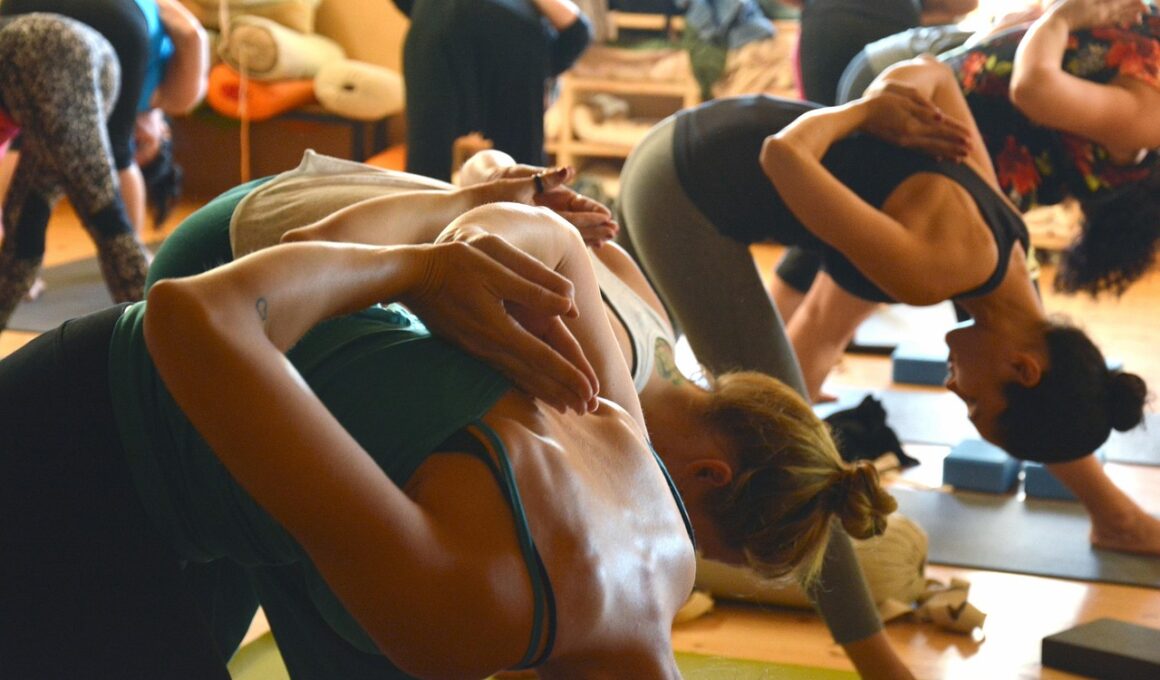The Science Behind Stretching: Why Group Classes Are Effective
Stretching is an essential component of fitness regimens that often gets overlooked. Many people recognize the importance of flexibility, yet they do not know how to incorporate effective stretching practices into their routines. Group fitness classes focusing on stretching and flexibility provide a structured environment conducive to enhancing flexibility while building a sense of community. These sessions typically include guided warm-ups, stretching techniques, and cooldowns, all under the supervision of professionals. Participants can receive feedback and motivation from instructors, enhancing their overall experience. In addition, group settings encourage accountability, making individuals more likely to attend and complete classes consistently. Moreover, the camaraderie developed among class participants can be a significant motivator. Together, individuals learn new techniques to improve their range of motion and decrease injury. This sense of belonging often results in individuals committing to their flexibility goals, which can promote positive mental well-being as well. Ultimately, engaging in group stretch classes can lead to improved physical health and a more enjoyable exercise regimen, making it a beneficial addition to any fitness plan.
The Benefits of Flexibility
Flexibility plays a crucial role in overall fitness and performance for individuals of all fitness levels. Enhanced flexibility can lead to improved posture, increased range of motion, and better overall balance. When muscles are adequately stretched, they function more efficiently during physical activities. This is particularly beneficial for athletes participating in performance-driven sports, where mobility can make a significant difference. Regular stretching increases blood flow, reducing muscle soreness and expediting recovery after workouts. Moreover, it helps alleviate tension and tightness in the muscles, contributing to an overall sense of relaxation. During group classes, instructors often emphasize stretching to promote the benefits of flexibility, allowing participants to gain a deeper understanding of its importance. Practicing stretching in a collaborative environment encourages sharing tips for moving correctly and effectively. Additionally, many people experience mental benefits from participating in group activities. Social interaction often reduces stress, promoting overall happiness. A positive mindset helps individuals remain committed to their flexibility goals. Therefore, motivating each other in a supportive environment enhances the number of benefits derived from group fitness classes focused on flexibility and stretching routines.
Group fitness classes that focus on stretching often incorporate various styles and techniques from multiple disciplines, making them diverse and engaging. Participants may experience elements of yoga, Pilates, and traditional stretches, ensuring a comprehensive approach to flexibility training. The combination of different techniques can keep classes fresh and interesting and helps target various muscle groups effectively. For instance, yoga-focused stretches may promote balance and relaxation, while more dynamic stretches can help athletes develop agility and strength. This layered approach caters to a wide audience, from beginners to more experienced individuals seeking advanced techniques. Each participant can find positions that challenge them at their level, allowing for personal growth and development in flexibility. Instructors often offer modifications and adjustments, ensuring everyone can participate. Another key benefit of group classes is the opportunity to learn from peers. Observing others can inspire individuals to try new techniques or push their limits. This collaborative environment fosters learning and sharing of best practices, creating a culture of support. As such, developing flexibility in a group setting can be both rewarding and enjoyable, reinforcing the benefits of collective growth in fitness.
Creating a routine that includes stretching can be challenging for many people, particularly those new to fitness. Attending group classes can eliminate the guesswork, as session plans are usually designed by qualified professionals who incorporate effective techniques. These classes typically emphasize the importance of gradual progression, ensuring that participants understand how to stretch safely and effectively. Due to the structured nature of group sessions, participants are less likely to push themselves too hard, which can lead to injuries. Instructors are there to guide individuals through the class and provide immediate feedback to ensure proper form. Furthermore, engaging in group stretching routines can help build friendships and support networks that encourage accountability. When individuals attend classes together, they often hold each other accountable to return and improve over time. This social aspect enhances the experience and adds an element of fun, making stretching feel less like a chore and more like a community activity. Ultimately, participants are more likely to stick with their stretching practices, contributing to long-term flexibility improvements, and promoting better overall health and wellness through group engagement.
Motivation through Community
Motivational aspects are essential in encouraging individuals to commit to regular stretching and flexibility practices. Group fitness classes provide an ideal setting for fostering motivation among participants. As individuals attend classes together, they can share personal goals, achievements, and challenges, invigorating group dynamics and camaraderie. This supportive environment increases accountability, which can be a vital factor in maintaining consistency in fitness routines. When a participant sees fellow classmates progress and improve their flexibility, it can ignite a competitive spirit, motivating them to strive for their goals. This collective motivation extends beyond class time, as participants often encourage each other to incorporate stretching into their daily routines. Engaging in meaningful conversations about progress or struggles can deepen connections and foster friendships, providing additional support beyond the classroom. Participants often celebrate achievements together, creating a shared sense of accomplishment and contribution to their growth. By consistently attending classes, individuals know they have a dedicated support system invested in their collective success. This environment encourages exploration, learning new techniques, and ultimately committing to achieving personal growth in flexibility and overall fitness.
While benefits are numerous, achieving success in stretching through group classes can be accompanied by challenges. Some individuals may initially feel intimidated by group settings, especially if they perceive themselves as less flexible than others. Instructors play a crucial role by creating an inclusive atmosphere that welcomes participants of all skill levels. They can help dispel anxiety by providing modifications and guidance tailored specifically for individual needs. Instructors can also encourage participants to focus on their own progress rather than comparing themselves to others, emphasizing that everyone is on their unique fitness journeys. Additionally, strategies like warm-ups and gradual progressions can help ease individuals into stretching routines, reducing the risk of injury. Clearing misconceptions and setting realistic expectations are vital for participants’ success. Flexibility takes time to develop, and participants need to understand this as they embark on their stretching journey. Finally, consistent attendance and practice not only contribute to individuals’ progress but also foster a sense of belonging within the class. By cultivating a supportive environment where individuals feel comfortable, group stretching classes can help attendees overcome various barriers, ultimately supporting flexibility and overall well-being.
Conclusion: A Lasting Impact on Health
Ultimately, group fitness classes focusing on stretching and flexibility hold great potential for individuals wishing to improve their physical well-being. The combination of motivation, collective support, and expert guidance creates an environment where participants can thrive. By incorporating diverse stretching techniques and providing a structured format, these classes offer valuable benefits that cater to various fitness levels. Individuals develop flexibility and physical balance that increases their agility during everyday activities and sports. The positive social atmosphere reduces stress and enhances emotional health, contributing to a more fulfilling experience for everyone involved. Group classes also foster long-term relationships that provide accountability and enhance motivation. Those participants who remain active in classes are more likely to engage in lifelong wellness practices. By establishing routine practices that prioritize stretching and flexibility, individuals can prevent injuries and ease discomfort. Overall, group fitness classes serve as a gateway to improved health, ensuring that participants achieve their fitness goals while cultivating a supportive community. Therefore, embracing the effects of stretching in a group setting can create lasting impacts on health and well-being, encouraging sustainable fitness practices for everyone.
In conclusion, participating in group fitness classes that focus on stretching and flexibility can significantly enhance an individual’s overall health and well-being. Whether you’re a seasoned athlete or just starting your fitness journey, these classes provide a supportive environment designed to encourage personal growth and improvement. The shared motivation cultivated through group dynamics helps participants stay committed to their flexibility goals, reaping the numerous advantages that arise from regular stretching practices. In combination with expert guidance and effective techniques, participants can experience improvements in flexibility, balance, and posture while preventing injury. More than just physical benefits, the social interactions and friendships built during group classes promote a holistic wellness approach, positively impacting each individual’s mental health and happiness. This makes regular attendance feel less like a task and more like a joyful experience with friends. Therefore, whether you are looking to increase your flexibility or simply find a new way to connect with others, group stretching classes might be the perfect fit for your fitness routine. With a focus on community and support, you are likely to thrive and achieve your stretching goals.


